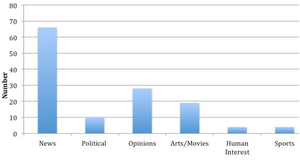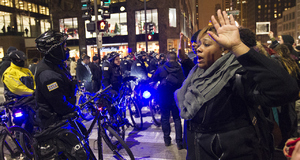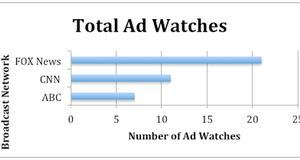From Elon Journal of Undergraduate Research in Communications VOL. 5 NO. 1The Agenda-Setting Potential of Saturday Night Live
IN THIS ARTICLE
KEYWORDS
AbstractThis study explored the effects of the late-night sketch comedy Saturday Night Live in the political sphere, specifically analyzing its impact using agenda-setting theory. As primarily secondary research, this study reviewed previous studies suggesting that satirical news segments and critical portrayals of politicians have a tangible effect on voters’ perceptions of political issues. In the 2008 Presidential Election specifically, vice-presidential nominee Sarah Palin’s favorability ratings dropped in accordance with the program’s parodies, illustrating Saturday Night Live’s possible influence on public perceptions of politicians and political issues by spotlighting critical issues and blending humor with truth. This study sheds light on the evolution of the program from mere entertainment to a political platform with the potential to influence viewers’ political beliefs. IntroductionThroughout its nearly 40-year run on American national television, the sketch comedy program Saturday Night Live has introduced viewers to memorable characters, from the aliens with cone-shaped heads, to the “Blues Brothers,” to “Wayne and Garth,” to the upright and uptight “Church Lady.” Beyond the entertaining and humorous, and fictional, creations of the show’s writers, the program’s political parodies, often skewering the politicians found in the most recent newspaper headlines, also garner significant media attention. In the past decade in particular, Saturday Night Live cemented a pivotal place in the world of politics. This work considers the question, particularly relevant given the show’s popularity throughout the past two national elections: “How, and to what extent, did Saturday Night Live set the political agenda?” The most recent literature about Saturday Night Live delves mainly into the 2008 political season, as Tina Fey’s portrayal of then-Alaskan governor Sarah Palin shaped the way the American public perceived the relatively unknown politician, and as some argue, influenced their decisions at the polls. The show’s increasing political power may be explained through the agenda-setting theory, which asserts that the media influences what issues the general public, or in this study, the Saturday Night Live viewers, perceive as the most important political values. The “Weekend Update” satirical news segment additionally bolsters the notion that the program plays an informative role, as the segment’s writers pull actual news headlines and spin them in a humorous light. Literature ReviewThe literature revolves primarily around Saturday Night Live’s history, evolution, and agenda-setting capabilities. Some sources argue that the program truly influences the political sphere, beyond providing pure entertainment. Generally, the work done on Saturday Night Live in recent years spotlights the “Tina Fey Effect,” pertaining specifically to the power exhibited by the program’s actors and writers in the past five years. Historically, little research on the show’s political satire has been conducted, although researchers have studied the program’s origins in political parodies. To broaden the study beyond just Saturday Night Live, additional literature on the agenda-setting theory itself, historically and in present-day was reviewed. Literature on other political satire programs, including The Daily Show and The Colbert Report, was also included to expand the discussion beyond one program’s style of political humor. The Agenda-Setting TheoryWeaver (1994) analyzes the evolution of the agenda-setting theory and asserts that the 1992 presidential election illustrated a shift in political power from the media to voters themselves. Weaver writes that the media’s ability to set the political agenda is dependent on several factors, including “prior knowledge of voters, the nature of the media coverage, the type of issues, and the kind of effects being measured (Weaver 348). He claims the media’s power is limited, but also asserts that the media can set the agenda by constructing a “perceived reality that voters rely upon in making decisions” (Weaver 349). A definition of agenda setting in a contemporary context is also integral to the discussion. Authors Guo, Vu and McCombs discuss the evolution of the agenda-setting theory and suggest that the media influences what issues are perceived as important, persuading the audience to believe that certain clusters of information are most important. The authors take a psychological approach to their research, countering that modern-day agenda setting is not a simple practice or linear storyline created by the media, but rather emphasizes connections between a political figure and one’s own background and beliefs. The Evolution of Political SatireBecker’s (2012) research further supports the argument that Saturday Night Live has set the political agenda in a presidential campaign. Becker’s work similarly analyzes the 2008 presidential election, focusing not on Palin, but on Senator John McCain, her running mate. Becker defines and compares the political satire on Saturday Night Live with Stephen Colbert’s deadpan satire on “The Colbert Report.” Although other literature pinpoints Saturday Night Live’s negative portrayal of Sarah Palin as one of the main reasons the McCain/ Palin campaign lost the presidency, Becker suggests that the program allowed McCain to salvage and boost his public image and political career by appearing on the show and lampooning himself in his campaign’s final days. In analyzing the agenda-setting effectiveness of Saturday Night Live on young adults, Holbert, Tchernev, Walther, Esralew, and Benski (2013) counter the notion that the program has the ability to subtly plant ideas or images in viewers’ minds. The authors agree that political parodies can contribute to young adults’ political knowledge, but assert that there are limitations for parodies in actually setting the political agenda. They suggest that young adults in particular are able to separate satire from truth, and are not persuaded by political parodies on television. The literature asserts that young adults are cognitively able to separate persuasive material from their own beliefs and may “avoid the message, counter-argue the message . . .” (Holbert et. all 173). In addition to its satirical characterizations of political figures, Saturday Night Live’s “Weekend Update” news segment also influences viewers’ political views. Reincheld (2013) describes the role of the comedic news segment in disseminating information to viewers, countering the argument that the program is mere entertainment. The literature describes the development of the segment, and show creator Lorne Michaels’ intent for “Weekend Update” to be considered a serious voice in the American political landscape and to serve an informational purpose” (Reincheld 191). Reincheld also sides with other researchers promoting the idea that Saturday Night Live plays an informative role, with cast members often learning about the news primarily from the segment’s jokes, mirroring similar work revealing that young adults who watch political parodies are more informed than those who do not. Saturday Night Live During the 2008 ElectionAuthor Dannagal G. Young (2013) discusses Saturday Night Live’s influence as a part of the political sphere after the show defined vice-presidential nominee Sarah Palin’s public image. Although David Weaver defines the press as the agenda-setting vehicle, Young casts Saturday Night Live as the ultimate powerholder during election times. Young asserts that the rise of news coverage and “emphasis on candidate personalities” enabled Saturday Night Live to create Palin’s public persona. The media focused primarily on Palin in comparison to Fey’s satirical portrayal, shifting the political discussion away from political issues to an actress’s characterization of a politician. The author analyzed the “Fey Effect,” where Fey’s portrayal of Palin is pinpointed as the basis for Palin’s increasingly unfavorable poll numbers. Young’s research contributes to the argument that Saturday Night Live does play a role in political agenda-setting, directly resulting in Palin’s inability to secure the vice-presidency. Esralew and Young (2013) also delve into the “Fey effect.” The authors support the idea that there is no longer separation between news and entertainment, countering literature equating Saturday Night Live to mindless entertainment without political agenda. The authors define modern agenda-setting as “not about direct persuasion but, rather, subtle cognitive effects that take advantage of how the brain is hardwired.” Instead of overtly telling viewers not to vote for McCain and Palin, Saturday Night Live subliminally planted cognitive shortcuts in viewers’ minds. Esralew and Young assert that agenda-setting is the first part of a twostep process, where agenda-setting spotlights certain issues in the media, followed by priming, where viewers “ascribe increased importance” to the issues (Esralew and Young 340). Abel and Barthel(2013), similarly utilize the depiction of Sarah Palin as evidence for the argument that Saturday Night Live influences how journalists and the mass media cover certain figures. The research primarily concerns the incorporation of political satire and comedy into the political information pool. The authors suggest that Saturday Night Live holds an impactful relationship with the general public, as they can inject their satire with political commentary that journalists must avoid. The two authors reference a possible “SNL Effect,” a recent theory similar to the “Fey Effect” that claims that the show truly does influence public opinion. They came to the conclusion that the program led the media to skewer and heavily criticize Sarah Palin after airing a critical sketch, while the media’s coverage of her prior to the episode was mainly favorable. Pfeifer (2013) claims that in the 2008 election, Saturday Night Live played an important role in the campaign’s narrative. Pfeifer explains the show’s significance through the “framing” theory, similar to the agenda setting theory, stating that political parody can shape viewers’ understanding and perception of political figures. He delves into the definition of a parody, and asserts that political parodies can be used to shape our beliefs and create new political realities. He also says political parody is not necessarily just an imitation, but can also contain added commentary. Pfeifer cites several sources that further the idea of political framing, in this case asserting that Saturday Night Live determines the storyline of an election, guiding viewers’ interpretations of media portrayals. The majority of literature on the subject supports the argument that Saturday Night Live agenda setting influences the political sphere and possesses the ability to set the political agenda. In accordance with the theory’s definition, the program shapes what viewers perceive to be the most prominent issues. Several researchers utilize the program’s depiction of Sarah Palin as a key piece of evidence in their assertions. However, the literature relies heavily on quantitative, rather than qualitative, data, drawing upon other media sources to support their arguments. Since the agenda-setting power of the show manifested most clearly in 2008, most of the literature only illustrates the agenda-setting effect during one election. The literature suggests that agenda-setting, and other political and sociological theories, reach beyond politics into the entertainment world.Continued on Next Page » Suggested Reading from Inquiries Journal
Inquiries Journal provides undergraduate and graduate students around the world a platform for the wide dissemination of academic work over a range of core disciplines. Representing the work of students from hundreds of institutions around the globe, Inquiries Journal's large database of academic articles is completely free. Learn more | Blog | Submit Latest in Political Science |

















